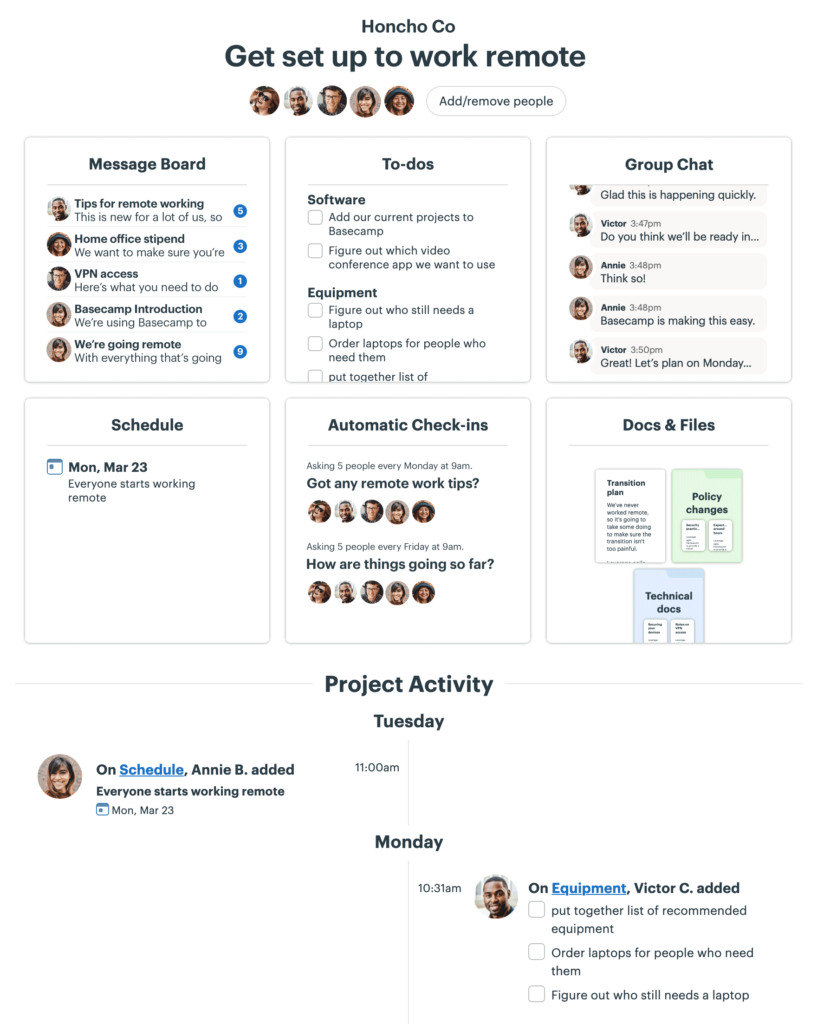Is Basecamp the right project management software for your team’s organizational needs? We will help you figure that out by discussing Basecamp’s benefits, pricing, and integrations. We will also reveal several things you should consider before selecting PM software since there are plenty of options out there.
What is Basecamp Project Management Software?
Founded in 1999, Basecamp is a project management software solution and tool that helps development teams collaborate in one place to save time, boost efficiency, and increase productivity. It is particularly helpful for teams of developers that are working remotely, as it can keep everyone (programmer and project manager) on the same page, regardless of location or time zone.
What are the Benefits of Basecamp PM Tool?
Sign up for Basecamp, and you can replace the messiness and confusion that comes with trying to collaborate via several different apps simultaneously. Here are some examples of Basecamp’s set of tools that can replace more common ones that software development teams rely on, thanks to its nature as an all-in-one project management solution for developers:
- Campfire – Group chat and sharing that replaces Slack and Hipchat.
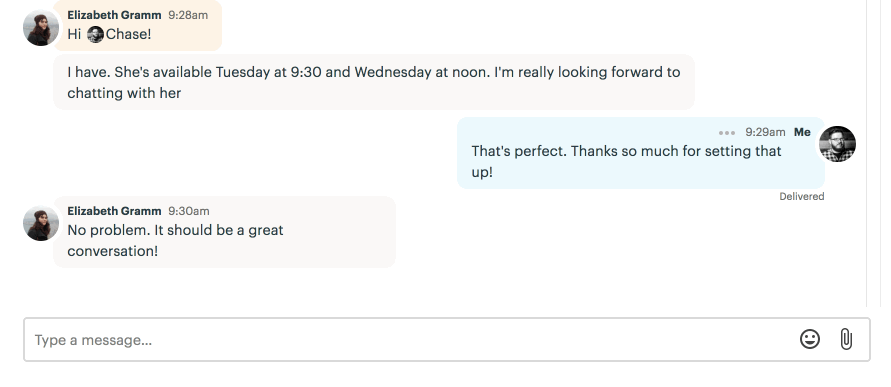
- Message Board – Replace messy and unorganized email threads with a place to post announcements, progress updates, feedback, and new ideas.
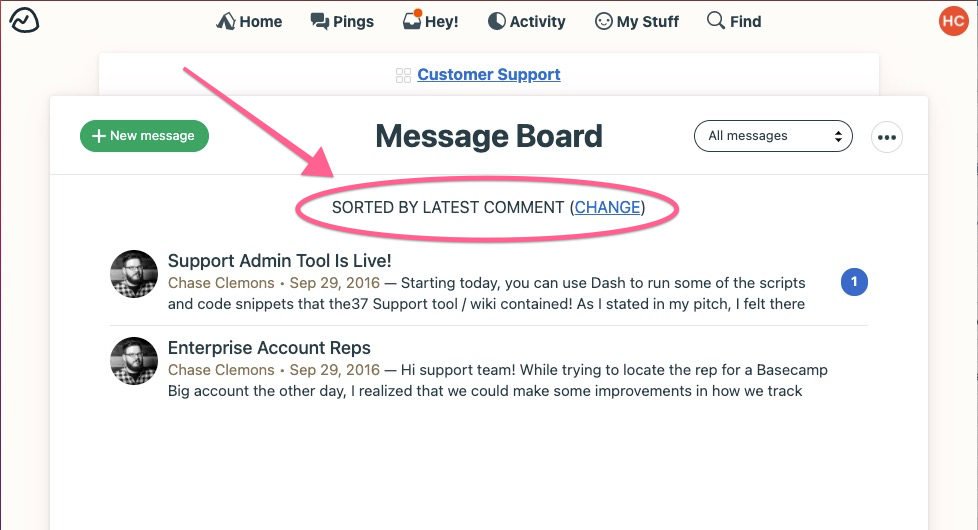
- To-dos – Create task lists, set due dates, and assign items in one spot versus relying on micromanagement.
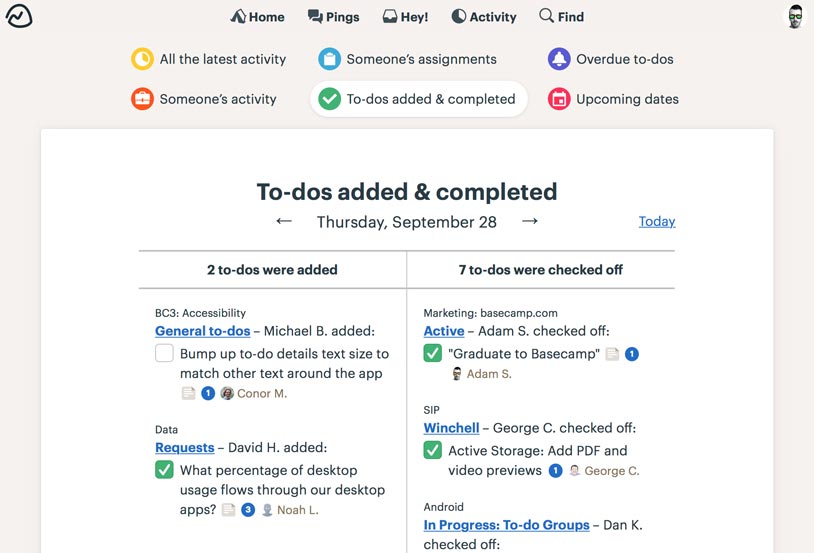
- Bug Tracking – Track various bugs, where they are in the “fix” stage, and which coder is working on them.
- Schedule – Set critical dates (such as release dates, scheduled patches or maintenance, or feature additions) and subscribe to events. It can also replace your personal calendar.
- Automatic Check-ins – Post recurring questions that team members can step in to answer without holding time-consuming status meetings or huddles.
- Docs and Files – A place to share documents, files, images, documentation, technical manuals, and spreadsheets versus having to look for them in Google Drive or Dropbox.
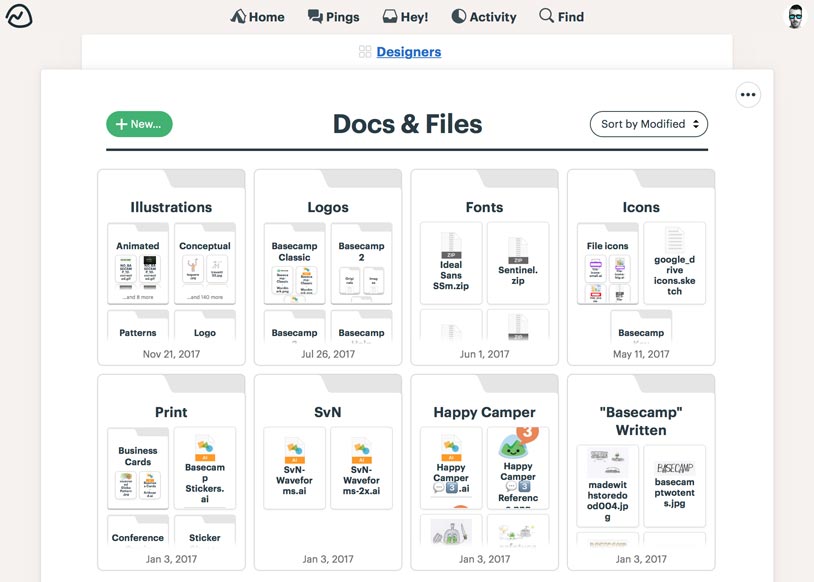
Reading: Best Project Management Tools for Developers
While Basecamp offers all the essentials you need to have a development project run smoothly, it also integrates with a plethora of third-party apps (which we list below) to boost its functionality even further.
Basecamp makes it easy to collaborate and manage software products via a unified interface. Instead of having your team’s information and progress scattered across various tools, you can have it all in one spot, so nothing slips through the cracks. This can save your team time, money, and frustration while keeping your clients satisfied since the likelihood of missing tasks and deadlines is significantly reduced.
For example, if you have deadlines for different versions of your app or particular modules to be launched, tested, or reviewed, you can keep track of the progress of all of those deadlines to ensure that they are on schedule. Further, you can track potential bugs or roadblocks – like access to resources – that may cause a delay in hitting the target deadline. If a customer requests an added feature, you can add it to the project timeline and give everyone on the team visibility so they can adjust their task schedule accordingly.
How Much Does Basecamp Cost?
You can give Basecamp a risk-free whirl thanks to its 30-day free trial that can be canceled any time and that does not require a credit card. Beyond that, you have two pricing options for using Basecamp, starting with its free Personal plan.
As you might expect, the free Personal plan is a stripped-down version of Basecamp that does not give you access to all of this project management software’s features. What do you get for free? The ability to manage up to three projects, access for 20 users, and 1GB of storage space. This plan is geared towards freelancers, students, small shop developers, freelance programmers, and families looking to make light use of PM software to manage personal projects.
To unlock Basecamp’s best features mentioned earlier in this review, you will have to opt for the Business plan. It costs $99 per month for your entire team, but you can enjoy a 15 percent discount if you pay an entire year upfront. Discounts are available for nonprofits, plus free accounts for teachers and students at K-12 schools or universities who pledge only to use Basecamp for classroom work. This is a particular bonus for Computer Science majors, project managers getting certifications, or veteran programmers that are taking classes at a university, hoping to add another language to their toolbelt.
True to its name, this paid plan is ideal for businesses looking to boost their software development teams’ efficiency. They can do so via the following features, which are all included in the $99 Business plan:
- Unlimited projects
- Unlimited users
- Unlimited clients and contractors
- 500GB storage
- team projects
- Project templates
- Advanced client access
- Priority support
If the $99 monthly fee seems steep, keep in mind how Basecamp gives you everything you need to manage projects efficiently in one place, such as messages, real-time chat, to-do lists, schedules, file storage, documents, and check- into the. In doing so, Basecamp not only offers the convenience of having everything in one place so you do not have to switch between apps, but it also replaces other apps that have their own monthly fees, such as Asana Premium (to-do lists), G Suite (docs and calendar), Dropbox for Teams (file storage), Slack (real-time chat). Add up the monthly fees for those four apps for just five people, and you nearly double Basecamp’s $99 price.
Reading: Why Post Project Reviews Are Important
What 3rd Party Developer Tools Integrate with Basecamp?
Although Basecamp offers everything you need to keep your team up to speed on its own, you can integrate the project management software with several third-party tools to extend its functionality even more. Here are the third-party developer tools that integrate with Basecamp:
Mobile and desktop apps:
- Automate.io
- CData software
- Field Trip
- Mr ToDo
- pleexy
- Project Buddy
- retool
- RSSBus
- TaskClone
- Timeshift Messenger
- To do helpers
- Unito.io
- Zapier
- ZohoFlow
Time Tracking, Invoicing, and Accounting:
- AssessTEAM
- calamari
- Centreli
- Clockify
- ever hour
- harvest
- MinterApp
- Noko Time Tracking
- PomoDoneApp
- TaskBill.io
- TeamTime app
- Tick
- Timely
- timeeye
- timesheetr
- toggle
- TrackingTime
- Zrix time tracking software
Reporting, Charting, and Planning:
- bridge 24
- Bright Gauge Software
- C!Stats
- ClickData
- DayBack Calendar
- DNS check
- Earned Value App
- EasyInsight
- expiration reminder
- Ganttify
- clip folio
- Mango Board
- MetaSAAS
- appeal
- slick plan
- To do numbers
- tracked
- work stack
Software Development Basecamp Addons:
- Git Helpers
- Honeybadger
- instabug
- Morris
- pull pokes
- Saber feedback
- ScrumDo
- TestLodge
- userback
- Usersnap Classic
- Ybug
Marketing, Design, and Asset Management:
Customer Service and Support:
- akita
- Doorbell.io
- EvantoDesk
- Jitbit Helpdesk
- PMS data migration
- SupportBee
Contracts and proposals:
Developer only tools
Reading: Best Project Management Software for Game Developers
How Do I Choose a Project Management Tool?
There is no shortage of project management software for developers on the market, so how can you ensure you pick the right one for your development team? While the selection process will vary according to your needs, here are some things you should consider when choosing a project management tool:
User friendliness
Chances are, your team members vary in terms of their technical skills. While some may be tech-savvy and have extensive programming knowledge, others may not be veteran coders or used to working in a project management environment. This is why user-friendliness is such an essential characteristic of PM software, as you want to ensure everyone on your team can use the product without having to endure a steep learning curve. The less time and money invested in training and onboarding, the better.
interface
Since you or your team will probably use the project management tool daily, you want an interface that is modern, streamlined, intuitive, and easy on the eyes – the last bit is particularly important for coders who already spend their entire day looking at monitors and different programs.
Having third-party integration for common apps and developer tools that you can use from one central location is also important, as it will save time and make your team more efficient, versus having to switch in and out of different applications.
Reading: Project Management Software Comparison: Asana vs Jira
task management
Can you manage tasks the way you want to? Does the PM software offer the right task management features that mesh with your team, such as Gantt charts and the like? Can you assign tasks and team members with ease? These are all critical questions to answer. If the PM tool does not offer these features – or a third-party integration that adds them – move on.
time sheets
PM software with timesheet capabilities can help you manage costs and keep track of the time spent to complete specific tasks to improve your estimates. Look for timesheet functionality in your PM tools to keep track of budget, human resources, and get a clear picture of where your team is spending their time.
scheduling
Complex software development projects require scheduling tools, like Gantt charts, to ensure everything runs smoothly. Smaller projects may not require these features, but if your development shop plans to ramp-up or grow, scheduling features are an important feature to look for.
reporting and sharing
Solid reporting features like graphical charts can help communicate progress better to stakeholders and other outsiders, who often require a visual reporting element to better digest information. Having the ability to share such data with team members or clients outside of the development team is essential too.
Security
If your data is not safe, you could run into catastrophic problems later on. Inserted malicious code, malware, or theft of proprietary code can all lead to disaster for a software development company. Make sure security is high on your list of project management features.
Reading: Review of Microsoft Project
customization
Can you customize the tool to fit the look and functionality you desire? Are there any APIs that you can use to tie into your project, can you “white label” the product so it matches your brand if you are allowing clients to use or view reporting or see where project timeliness stands? If not, it may not be the right fit for you.
pricing
Does the PM software fit your budget? Does it offer a free plan or trial so you can test out its features first? Are most of the essential features included in the monthly price, or are you charged for each extra? Be sure to pay attention to add-on charges for things like support, additional users, or add-ons, as these “hidden” costs can rapidly add up.
read more project management software and tool reviews, comparisons, and tutorials.
